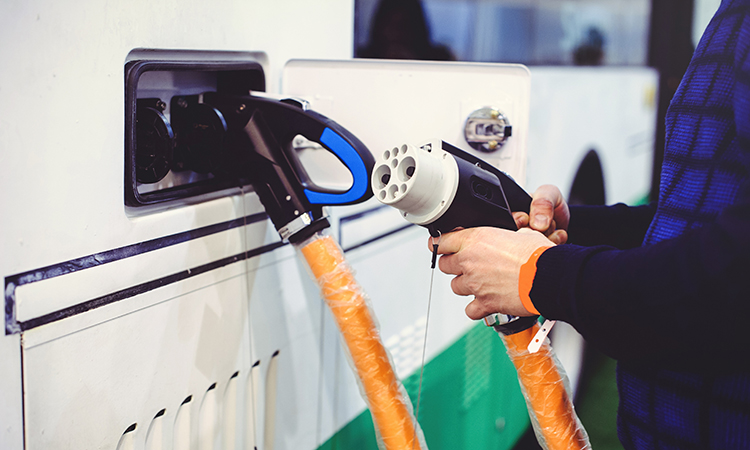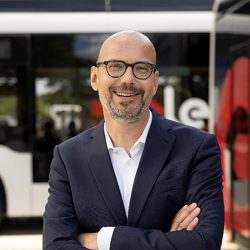Roundtable: Driving a more sustainable transport industry forward with e-mobility
- Like
- Digg
- Del
- Tumblr
- VKontakte
- Buffer
- Love This
- Odnoklassniki
- Meneame
- Blogger
- Amazon
- Yahoo Mail
- Gmail
- AOL
- Newsvine
- HackerNews
- Evernote
- MySpace
- Mail.ru
- Viadeo
- Line
- Comments
- Yummly
- SMS
- Viber
- Telegram
- Subscribe
- Skype
- Facebook Messenger
- Kakao
- LiveJournal
- Yammer
- Edgar
- Fintel
- Mix
- Instapaper
- Copy Link
Posted: 6 January 2023 | Intelligent Transport | No comments yet
In Issue 3 2022 of Intelligent Transport, our E-Mobility Roundtable brought together key industry personnel to discuss how the public transport industry is adapting in order to shift away from polluting diesel vehicles to more sustainably powered ones, as well as the adjustments to operational processes that operators must consider when looking to introduce these new types of vehicles.


As the public transport industry experiences increasing pressures to decarbonise in the face of worsening climate change, operators across the globe are working to identify the best ways in which to reduce their emissions. E-mobility is often considered to be the best option, owed to the fact that the technology is far more developed and accessible than other alternative power solutions.
This ‘roundtable’ brings together key industry personnel and those passionate about sharing their opinions on e-mobility to discuss how the public transport industry is adapting in order to shift away from polluting diesel vehicles to more sustainably powered ones, as well as the adjustments to operational processes that operators must consider when looking to introduce these new types of vehicles.
Participants
  |
  |
  |
| Jon Eardley | Adrian Meissner | Toralf Müller |
|
Managing Director, |
Key Account Manager, |
CEO, |
How significant a role is e-mobility playing in the decarbonisation of public transport?


One of the greatest strengths of e-mobility in decarbonising public transport is its ability to be introduced effectively at both a large and small scale, sometimes using existing spare grid capacity for small scale introductions or developing large scale fleet delivery via innovative battery storage or flexible grid supply options. This scale agility makes electrification a more attractive proposition for public transport providers requiring a single solution or architecture for a variety of depot and fleet requirements.
The ability to implement this technology, and the advances that have occurred in technology, has allowed operators to play a significant role in the improvement of air quality in cities and promote public transport as a more sustainable form of travel.


With the percentage of renewable energy in the energy mix for producing electricity rising, electric-powered buses become even cleaner and more sustainable. With more than 50,000 buses in use in public transport in Germany alone, the transition to battery electric buses helps to save a significant amount of carbon dioxide and reduces other emissions, too (such as fine particles, nitrogen oxide, noise, etc.).


At VHH, we have been providing bus services for nearly 100 years and, now, we are in the middle of a significant transition – going from 100 years of combustion-engine transport to non-combustion-engine transport. That’s a major change. In normal times, we have nearly over 120 million passengers using our services. However, these passenger numbers are not so important – it’s the 160 routes that we use to transport our passengers which are really important. These are heavily used routes, transporting more than 40,000 passengers per day. Then, you have to consider the 13 bus depots that we have in Hamburg, where as little as 20 buses to maybe 200 buses are stored and maintained. Transforming these to e-mobility is one of the major tasks that we have to achieve.
What are the benefits of choosing electric‑powered vehicles over other forms of alternative power, such as hydrogen or CNG?


Hydrogen is only very rarely available as ‘green’ hydrogen that is produced with renewable energy. Most available hydrogen is ‘grey’ hydrogen, coming from other industrial sources. Also, the efficiency of hydrogen-powered vehicles, compared to battery electric vehicles, is much lower. Prices for hydrogen-powered buses are significantly higher, too, compared to the prices of battery electric buses. All of this would need changes to make hydrogen an alternative for mass transport.
There sure are, at least at the moment, niches where hydrogen-powered buses make sense. In regional transportation, with large distances between bus stops and only few opportunities for recuperation or re-charging underway, hydrogen-powered buses have a niche.
And, with prices for battery electric buses falling and battery capacities rising, together with smart systems supporting bus operators (like INIT’s smart depot management systems, charging managements system and optimised planning of blocks), the challenges of transitioning to and the operation of battery electric buses can be handled.
CNG was a bridge technology that is dwindling, especially now with gas prices on a high and a situation where supplies of gas in many parts of the world cannot be guaranteed, and it is not as attractive anymore. Although, in Europe, there is the taxonomy of labelling gas as sustainable energy, but there is a growing resistance in the public against this label, as gas usually is a fossil energy.


In terms of the disadvantages, on larger fleets, the infrastructure for electric buses costs much more than for hydrogen buses, which makes it difficult to scale the infrastructure for electric buses. In my opinion, the greatest disadvantage would be that we have to manage the range and loading time for electric buses much more closely than for their hydrogen counterparts.
While hydrogen buses are a great alternative to tradition diesel vehicles, the demand for green hydrogen poses the biggest challenge to the wider adoption of this alternative fuel. On the other hand, with electric buses, we can usually transition faster and more easily. This may change in the future, but this is where I think we currently stand as an industry. However, in other locations/ countries with different conditions, views on these sustainable fuels may differ. This is why it is important that we look at the specific conditions and requirements of a company when deciding on which green fuel we use to decarbonise our public transit fleets. For the time being, our decision here in Hamburg is to achieve this with electric buses.
What are the challenges that transport operators face when looking to introduce electric vehicles in their operations?


For some applications, opportunity charging is an option, providing significant benefits for operators as it lowers the overall peak power requirements for an operational site and also reduces the required battery capacity for vehicles. It also has the potential to reduce the onsite charge infrastructure and allow for a more traditional, diesel-like stabling arrangement. An opportunity charge solution does, however, require a greater degree of collaboration with third parties and also restricts future network changes of vehicles, dependent on location-specific route infrastructure. Under the right circumstances, and in close collaboration with local transport authorities, this can be a sophisticated and highly effective e-mobility solution.
Away from opportunity charging, one of the most important elements to understand early on in planning is to establish what surplus grid power is available within the operator’s existing sites and the surrounding areas; knowing this is key and could influence the type of technology deployed. A site with readily available grid capacity would have a myriad of options available to it, enabling deployment at scale without compromising on vehicle type or charging solution. A site with limited available power would need to think much more carefully about the requirements of fleet charging and the ‘charging window’, mapping the vehicle run-in times to expected state of charge to ensure that each vehicle has sufficient time (and supply) to charge. This could influence decisions on whether or not to opt for an AC charge solution or a faster charging and more flexible DC solution, which can affect the type of vehicles deployed. The key to solving this is working with good partners in the supply chain – from the DNO or, in many cases, an IDNO – who can provide a flexible range of solutions for supply and site civil works to unlock the potential for the site with Independent Connection Partners (ICP) and Charge Point Operator (CPO) partners. These relationships are essential and will become as strategically important to operators as their relationships with vehicle manufacturers and maintenance providers.
Finally, telematics and fleet/charger management solutions will need to bring it all together; ensuring interoperability between vehicles and infrastructure is key to this and will help to optimise the use of the fleet and infrastructure to meet warranty and performance requirements and protect the assets throughout their design life.


On the operational side, there are range limitations under certain circumstances and the charging of the buses. On the depot and maintenance side, the processes of vehicle handling and the need to adapt the infrastructure (fire safety, energy provision).
The process of block planning for diesel buses has been established for decades. The behaviour of diesel buses is well-known, and outer influences like temperature (cold or heat) is neglectable. With battery electric buses, there is the need to adopt planning if you want to use the vehicles in an efficient way. You cannot put a battery electric bus on a typical diesel block and hope that it will work. Therefore, many operators use the buses only on short blocks, wasting the potential of the vehicles and wasting money.
As re-charging is different from re-fuelling vehicles and has its own rules and problems, the infrastructure needs to be adapted. The capacity of powerlines needs to be extended; power limitations must be taken into account. Systems that help to prevent reaching power limits and ensuring the operability of the vehicles (e.g. the INIT charging management and depot managements solutions) must be introduced.
As fire safety regulations are different for electric buses, firewalls must be built, the layouts of the depots need to be altered and second levels in the workshops are needed to work on the rooftops of the buses, where the batteries are located.


However, with electric buses, we have more restrictions. First, there is a restriction on range limitations – we need to introduce loading times. Second, electric buses are much more expensive than a standard diesel vehicle, so we simply can’t afford to have as many spare electric buses like we do for diesel buses. Furthermore, more needs to be done in order for our asset utilisation to increase. Therefore, when introducing EVs to our operations, we have three additional demands – how can we manage asset utilisation? How can we manage range limitations? And how can we manage loading time? – which makes it much more complicated. In order to manage these complexities, we have to shift from manual-managed processes to digital processes to get it done, especially when we have to run 650 buses on 30 locations, for example, making it difficult to do so manually. Thus, we have heavily invested in the digitalisation of all of our processes.
Furthermore, when introducing electric buses, it’s not only the vehicles that pose a challenge, but also the infrastructure. In order to support this, we have developed models looking at how we can change our infrastructure to meet the requirements of electric vehicles. An example of this is our workshop in Bergedorf, which we have re-designed to better cater for electric buses. We understood that, in comparison to traditional diesel buses, electric buses require repairs from all sides of the vehicles, especially from the top. To support this, we changed the design so that we can repair and maintain buses from all four sides, from the top and from the bottom. Now, workers can go up there and lift the bus, as well. We also have much more space in between the lines, so we can see how we operate the buses and have enough safety space when we do high-voltage operations.
In addition, it is also important that we take our staff into consideration, as they play a vital role in fostering this transformation. We understand that, when we adopt emission-free transport, we have to adapt everything in our company and ensure that our people are being trained and are in the right mindset to support this transition efficiently. We are committed to training all of our staff and trying to convince all of our mechanics to learn more about working with electric buses, including operating with computers on the buses and changing DC chargers. From the responses that we’ve had, many have said that they enjoy the training, while many of our drivers and workers in the workshop have said that they like the electric buses, as they’re easier to maintain and drive.
How can optimising operational processes help to deliver better results when implementing electric modes of transport?


An example of this is range anxiety. It is well documented that electric vehicles traditionally do not have the operational range of a combustion engine vehicle and, although the gap is closing, the range challenges of electric vehicles force operators to schedule in a safety margin for range risks; especially during cold weather and, more recently, extreme heat, where the auxiliary systems on the vehicle reduce the vehicle range and/or the charge rate at depot. Incentivising efficient driving is an effective way to combat this and, whilst most operators have been applying similar methods for years to reduce fuel consumption, the benefits of optimising efficient driving of an electric vehicle are far more critical to the operation than they would be for a typical diesel fleet. Reducing energy consumption optimises the range, reduces battery depth of discharge and shortens the charge window; through incentivisation or ‘gamification’ of promoting efficient driving, this can yield significant results at scale.
Another benefit of process optimisation is maximising the use of parking space on-site. Beyond the initial grid supply and infrastructure requirements for the site, the type of chargers and how they’re coupled to vehicles will impact the space available for parking; in some cases, by up to 15 per cent. Introducing a small number of electric vehicles allows operators to find ‘a corner of the yard’ to place them, typically with good cable access to the grid supply to the site. This approach is risky, as piecemeal electrification could result in the site running out of space in the future or ending up with an inefficient and, potentially, more dangerous vehicle movement area. An operator can combat this by starting from an ‘endgame’ position and working backwards to the start. That way, the electrification process can be worked up in phases, in a space-efficient and deliberate way, reducing the overall footprint of the infrastructure and unlocking innovative ways of stabling and charging the fleet. By thinking more strategically about the electrification of the site, the overall operation could be fundamentally changed for the better and not just to combat the ‘last in, first out’ vehicle issue that some of the more challenging sites suffer.


With our Operations Controls systems, we at INIT support bus operators with their daily operations. The depot management system knows all of the parameters of the buses and blocks and creates charging plans according to the company’s requirements. The charging management system then handles the charging process and guarantees that the power limitations are not exceeded, preventing too high prices for electricity. And the combination of both systems ensures that, even in the event of charging problems, the operation of the fleet is guaranteed by the optimised autonomous re-assignment of vehicles to blocks and the adaptation of charging plans.
The INIT fleet management system monitors vehicles during operations, keeping track of the State-of-Charge (SoC) and alerting the dispatchers if vehicles face the danger of not being able to fulfil the block. Furthermore, the fleet management system transmits the SoC of the vehicles prior to their arrival to depot management, allowing for the adaption of the assignments in advance, if necessary.


What role does effective fleet management play in operating a successful e-mobility fleet?


Depot management systems were hardly ever in use with diesel buses. Only a small percentage of bus operators use such systems so far, as the routines and processes of handling diesel buses are quite simple. Buses return from service, are re-fuelled, cleaned and parked. Very often, parking is sorted by vehicle type, so that any vehicle available can be taken to perform the service. Here, re-fuelling and parking are separated from each other.
With electric buses, charging of the vehicles often takes place at the parking position, which means that any problems during the charging process can lead to a domino effect that impacts other vehicles, too, if parking restrictions – like parking vehicles in rows behind each other – are in place, endangering operations. Therefore, fully automated monitoring of the charging process is a must, utilising the optimised re-assignment functionality of the depot management system.


Do you think that the widespread introduction of e-mobility will be the turning point for the public transport industry?


Firstly, the introduction of electrification and other technologies – such as hydrogen fuel cell, CNG and even the potential of hydrogen combustion – have propelled the public transport sector to the forefront of alternative power. The duty cycle of a city bus lends itself perfectly to the use of such technologies, and our industry has become the playground for innovative organisations who want to use our networks to develop their solutions.
For decades, the bus industry used engines designed for truck or van applications, shoehorned into a cupboard at the back of the bus and running hotter than they were designed to, leading to unreliability and a higher maintenance burden. Since the introduction of hybrid vehicles 15 years ago, the humble bus began to move ahead of other commercial road vehicles and is now the driving force in many of the alternative power technologies, both in shear volumes and in the variety of the innovative vehicle and infrastructure solutions being implemented by operators and their supply partners. This turning point has led to a technology revolution within the public transport industry that, using its unique place in society, it needs to seize upon to attract the best talent and innovative partners from all sectors to drive modal shift and combat climate change.
Outwardly, the introduction of e-mobility is already driving change. Many transport authorities are mandating zero-emission fleets for tenders and also for commercial operations via clean air zones. The shift in sales volumes towards zero‑emission vehicles for many bus manufacturers has been seismic in the last couple of years and tracks well ahead of sales percentages for other transport modes. The industry has the opportunity to showcase these technologies to society, as a shining example of how sustainable, decarbonised transport can work; in many towns and cities, it is already doing this and will only increase as long as it is funded appropriately.
The benefits of electrification and other zero‑emission vehicles can also be seen in vehicle design. No longer is the saloon compromised by the power train configuration or vibrations and noise from a diesel unit; batteries can be housed around the vehicle and near silent traction motors in wheel hubs or neatly packaged underfloor. This maximises the passenger saloon and creates an uncluttered space with no-step access throughout, allowing manufacturers and operators to create a much more inviting and spacious customer experience on-board; this is essential to entice future customers from their electric cars or scooters.
The changes in design also allow for a focus to return to the customer and how to offer a superior offering to encourage modal shift. Abellio demonstrated this with the introduction of the new electric vehicles on London’s Route 63, where it has been possible to bring innovative interior design ideas to the city’s network, offering more comfortable, brighter and safer interiors for customers.


For example, our simulation tool allows our customers to calculate the impact of the introduction of electric buses to the fleet, even before the first bus is purchased. This is important for tenders and helps to save a lot of money, especially with companies being on a tight budget after the pandemic. Furthermore, even bus manufacturers use our simulation tool to model the behaviour of the buses under different circumstances. That shows how much trust our customers have in our products and what expertise we have gained over the years. Our other solutions, like our depot management and charging management systems, are being introduced to more and more customers worldwide, as new demands grow out of the challenges of handling electric buses. And, also, more and more transport providers are deciding to incorporate live range prediction and control into their fleet management for a smoother public transport service.
Interoperability of systems has become more important than ever. New communications standards emerge and we at INIT, being a member of the VDV, help to shape these new standards for the benefit of the public transport industry.
Only those players in the market that are able to offer high quality solutions will survive over the next decade – and INIT will be one of them, spearheading and shaping part of the future of electromobility.


Related topics
Alternative Power, Fleet Management & Maintenance, Public Transport, Sustainable Urban Transport, Workplace
Issue
Issue 3 2022
Related modes
Bus & Coach
Related countries
Germany, United Kingdom
Related organisations
Abellio London Bus, INIT, Verkehrsbetriebe Hamburg‑Holstein GmbH (VHH)
Related people
Adrian Meissner, Jon Eardley, Toralf Müller








